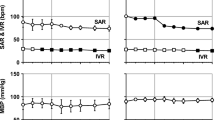Abstract
The antiarrhythmic and direct cardiovascular effects of a new antiarrhythmic agent, bidisomide, α-{2-[acetyl(1-methylethyl)amino]ethyl}-α-(2-chlorophenyl)-1-piperidinebutanamide, were investigated. To determine the antiarrhythmic effects, spontaneously occurring adrenaline-, digitalis-and two-stage coronary ligation-induced arrhythmias were used. Bidisomide suppressed these three arrhythmia models. The antiarrhythmic plasma concentration, IC50, of bidisomide for digitalis-induced arrhythmia was 22.1 μg/ml, and those calculated for intravenous bidisomide in 24 h and 48 h coronary ligation-arrhythmias were 15.1 and 11.6 μg/ml and that calculated for oral bidisomide in 24 h coronary ligation-arrhythmia was 5.4 μg/ml and that for adrenaline induced arrhythmia was 58.7 μg/ml. In the blood perfused sinoatrial node and papillary muscle preparations, bidisomide decreased the sinoatrial rate and contractile force and increased the intraventricular conduction time and coronary blood flow. These results indicate that bidisomide is similar to other class I antiarrhythmic agents such as pirmenol and KW-3401 in its antiarrhythmic profile and is expected to become a clinically useful antiarrhythmic drug.
Similar content being viewed by others
References
Garthwaite S, Hatley F, Frederick L, Ruby J, Cook C: Effect of SC-40230, a new class I antiarrhythmic agent, on canine ventricular tachycardias. Drug Dev Res 17: 119–133, 1989
Spinelli W, Hoffman BF: Mechanisms of termination of reentrant atrial arrhythmias by class I and class III antiarrhythmic agents. Circ Res 65: 1565–1579, 1989
Martin CL, Borowicz LE, Schniepp HC, Sanguinetti MC: Voltage-and rate-dependent reduction of Vmax of cardiac action potentials by SC-40230. Drug Dev Res 17: 51–61, 1989
Frederick LG, McDonald SJ, Garthwaite SM: Cardiovascular profile of a new anti-arrhythmic agent, SC-40230. Cardiovasc Res 23: 897–903, 1989
Hashimoto K, Satoh H, Shibuya T, Imai S: Canine-effective plasma concentrations of antiarrhythmic drugs on the two-stage coronary ligation arrhythmia. J Pharmacol Exp Ther 223: 801–810, 1982
Hashimoto K, Ishii M, Komori S, Mitsuhashi H: Canine digitalis arrhythmia as a model for detecting Na-channel blocking antiarrhythmic drugs: A comparative study using other canine arrhythmia models and the new antiarrhythmic drugs, propafenone, tocainide and SUN 1165. Heart and Vessels 1: 29–35, 1985
Shibuya T, Hashimoto K, Imai S: Effective plasma concentrations of antiarrhythmic drugs against sustained halothane-adrenaline arrhythmia in dogs. J Cardiovasc Pharmacol 5: 538–545, 1983
Hashimoto K, Haruno A, Matsuzaki T, Sugiyama A, Akiyama K: Effects of antiarrhythmic drugs on canine ventricular arrhythmia models: Which electrophysiological characteristics of drugs are related to their effectiveness? Cardiovasc Drugs Ther 5: 805–818, 1991
Sugiyama A, Motomura S, Tamura K, Hashimoto K: Comparison of cardiovascular effects of pirmenol with those of disopyramide in isolated canine heart preparations cross-circulated with a donor dog. Jap J Pharmacol 53: 97–110, 1990
Hashimoto K, Komori S, Ishii M, Kamiya J: Effective plasma concentrations of aprindine in canine ventricular arrhythmias. J Cardiovasc Pharmacol 6: 12–19, 1984
Hashimoto K, Ishii M, Komori S: Antiarrhythmic plasma concentrations of mexiletine on canine ventricular arrhythmias. J Cardiovasc Pharmacol 6: 213–219, 1984
Hashimoto K, Akiyama K, Mitsuhashi H: Antiarrhythmic plasma concentrations of cibenzoline on canine ventricular arrhythmias. J Cardiovasc Pharmacol 9: 148–153, 1987
Hashimoto K, Akiyama K, Mitsuhashi H: Antiarrhythmic effect of a new class I antiarrhythmic drug, nicainoprol, on canine ventricular arrhythmias. Jap J Pharmacol 49: 245–254, 1989
Hashimoto K, Watanabe K, Mochizuki S, Tomiyama A: Effects of KT-362, a new Na and Ca influx and Ca release inhibitor, on canine ventricular arrhythmias. Jap J Pharmacol 51: 475–482, 1989
Hashimoto K: Pharmacology of TYB-3823, a new class I antiarrhythmic drug. Cardiovasc Drug Rev 9: 413–423, 1991
Hashimoto K, Sugiyama A, Haruno A, Matsuzaki T, Hirasawa A: Effects of a new antiarrhythmic drug TYB-3823 on canine ventricular arrhythmia models. J Cardiovasc Pharmacol 17: 336–342, 1991
Sugiyama A, Motomura S, Hashimoto K: Comparison of cardiovascular effects of a novel class Ic antiarrhythmic agent, NIK-244, with those of flecainide in isolated canine heart preparations cross-circulated with a donor dog. Jap J Pharmacol 56: 1–12, 1991
Author information
Authors and Affiliations
Rights and permissions
About this article
Cite this article
Zhenjiu, W., Awaji, T., Hirasawa, A. et al. Effects of a new class I antiarrhythmic drug bidisomide on canine ventricular arrhythmia models. Mol Cell Biochem 119, 159–169 (1993). https://doi.org/10.1007/BF00926867
Issue Date:
DOI: https://doi.org/10.1007/BF00926867




